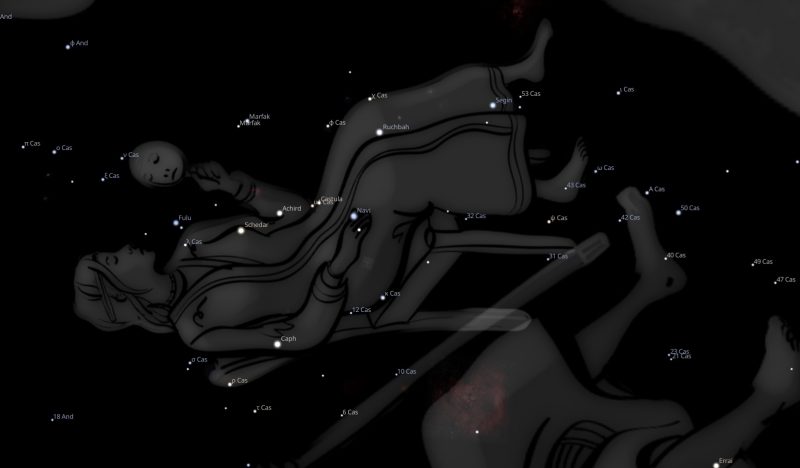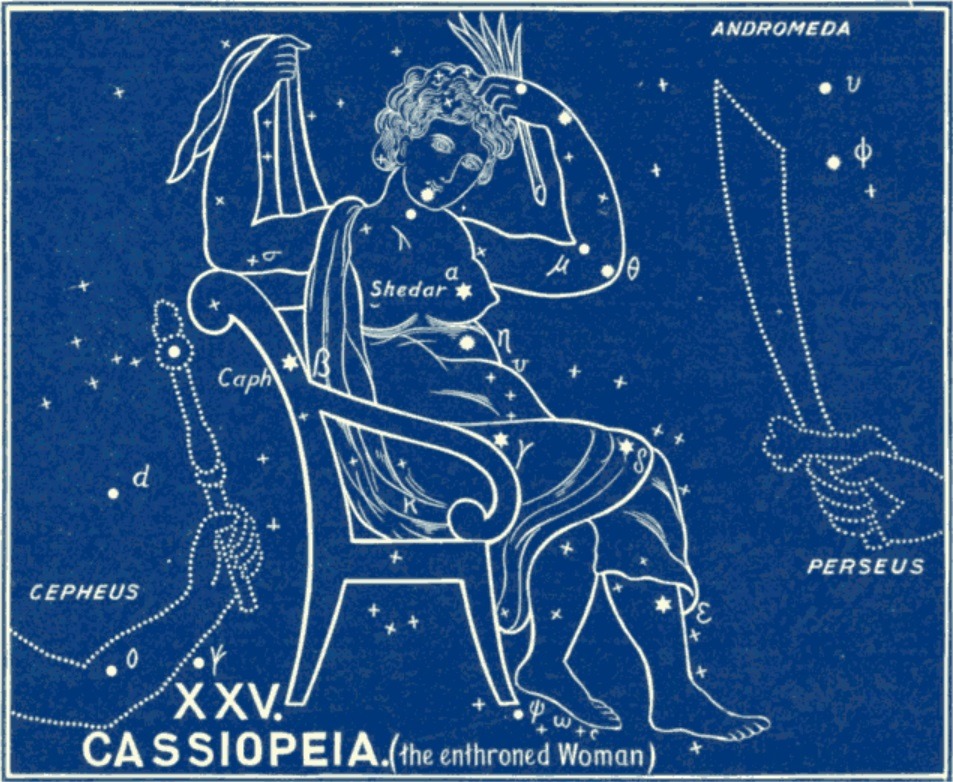FIXED STARS: Major Stars | 1000+ Stars | Constellations | About
Constellation Cassiopeia the Queen, or Seated Woman, is a northern constellation bordering Perseus, Andromeda, Cepheus and the obsolete constellations Frederici Honores, Rangifer and Custos Messium.Cassiopeia is one of the 48 constellations listed by Ptolemy in the 2nd century and remains one of the 88 modern constellations. It spans 40 degrees of the zodiac in the Sign of Taurus and Gemini.
Abbreviation: Cas
Genitive: Cassiopeiae
Cassiopeia Constellation Stars
| 2000 | 2050 | Star | Name | Sp. Class | Mag. | Orb |
|---|---|---|---|---|---|---|
| 01♉03 | 01♉45 | ρ Cas | F8 | 4.51 | 1°10′ | |
| 02♉28 | 03♉10 | ο Cas | B5 | 4.48 | 1°10′ | |
| 05♉04 | 05♉46 | ζ Cas | Fulu | B2 | 3.69 | 1°40′ |
| 05♉08 | 05♉50 | β Cas | Caph | F2 | 2.28 | 2°10′ |
| 07♉47 | 08♉29 | α Cas | Schedar | K0 | 2.24 | 2°10′ |
| 10♉16 | 10♉58 | η Cas | Achird | G0 | 3.46 | 1°40′ |
| 11♉14 | 11♉55 | μ Cas | Marfak West | G5 | 5.17 | 1°00′ |
| 11♉48 | 12♉30 | θ Cas | Marfak | A7 | 4.34 | 1°10′ |
| 12♉36 | 13♉18 | υ2 Cas | Castula | G8 | 4.62 | 1°00′ |
| 12♉36 | 13♉18 | κ Cas | B1 | 4.17 | 1°20′ | |
| 13♉56 | 14♉38 | γ Cas | Navi | B0 | 2.47 | 2°10′ |
| 17♉56 | 18♉38 | δ Cas | Ruchbah | A5 | 2.68 | 2°00′ |
| 24♉46 | 25♉28 | ε Cas | Segin | B2 | 3.35 | 1°40′ |
| 29♉29 | 00♊10 | 23 Cas | Shǎochéng | B8 | 5.42 | 1°00′ |
| 01♊55 | 02♊37 | A Cas | A3 | 4.49 | 1°10′ | |
| 02♊14 | 02♊56 | ι Cas | A5 | 4.46 | 1°10′ | |
| 03♊34 | 04♊16 | 50 Cas | A2 | 3.95 | 1°30′ | |
| 07♊46 | 08♊28 | 49 Cas | G8 | 5.22 | 1°00′ | |
| 09♊07 | 09♊49 | 47 Cas | Dōngfāngcāngdi | F0 | 5.27 | 1°00′ |
47 and 49 of Cassiopeia also belonged to the obsolete constellation Rangifer.
Cassiopeia Astrology
Manilius
and Cassiepia, her face upturned to witness the sacrifice she caused… Cassiope will produce goldsmiths who can turn their work into a thousand different shapes, endow the precious substance with yet greater value, and add thereto the vivid hue of Jewels. From Cassiope come the gifts of Augustus which gleam in the temples he consecrated, where the blaze of gold rivals the sun’s brightness and the fires of gems flash forth light out of shadow. From Cassiope come the memorials of Pompey’s triumph of old and the trophies which bear the features of Mithridates: they remain to this very day, spoils undimmed by the passage of time, their sparkle as fresh as ever.
From Cassiope come the enhancement of beauty and devices for adorning the body: from gold has been sought the means to give grace to the appearance; precious stones have been spread over head, neck, and hands and golden chains have shone on snow-white feet. What products would a grand lady like Cassiope prefer her sons to handle rather than those she could turn to her own employments? And that material for such employment should not be lacking, she bids men look for gold beneath the ground, uproot all which nature stealthily conceals, and turn earth upside down in search of gain; she bids them detect the treasure in lumps of ore and finally, for all its reluctance, expose it to a sky it has never seen. The son of Cassiope will also count greedily the yellow sands, and drench a dripping beach with a new flood; he will make small weights to measure the tiny grains, or else will collect the wealth of gold-foaming Pactolus; or he will smelt lumps of silver, separating the hidden metal and causing the mineral to flow forth in a running stream; otherwise he will become a trader of the metals produced by these two craftsmen, ever ready to change coinage of the one metal into wares of the other. Such are the inclinations which Cassiope will fashion in those born under her. [1]
Maternus
Cassiopeia arises in the 20th degree of Aquarius. Those who are born with this rising will be goldsmiths, goldbeaters, gilders, plasterers, and pearl-setters, carrying on all these arts with talented skill. They will have very great income from these arts. But if this constellation was found in the DSC, those who are born will perish from the collapse of a building, or they will die murdered. [2]
Robson
Legend. Cassiopeia, the wife of Cepheus and mother of Andromeda, was taken into heaven in consideration of the deeds of Perseus (see ANDROMEDA). She is said to have boasted that not only Andromeda but she herself was fairer than the Nereids, and for that reason she was bound to her chair and condemned to circle the pole head downwards as a lesson in humility.
Influence. According to Ptolemy this constellation is of the nature of Saturn and Venus. It is said to give haughtiness, boastfulness and exaggerated pride, but at the same time the power of commanding respect. It is associated by the Kabalists with the Hebrew letter Beth and the 2nd Tarot Trump “The High Priestess.”
Magical. Restores weak bodies and strengthens members. [3]
Noonan
The constellation Cassiopeia (Cas) presages events that concern Africa and African people. Its bright stars are said to have the nature of Saturn (Schedir) and Venus (Rucha). [4]
Allen
Cassiopeia, or Cassiope, more correctly Cassiepeia, although variously written, is one of the oldest and popularly best known of our constellations, and her throne, “the shinie Casseiopeia’s chair” of Spenser’s Faerie Queen, is a familiar object to the most youthful observer. It also is known as the Celestial W when below the pole, and the Celestial M when above it.
Hyginus, writing the word Cassiepia, described the figure as bound to her seat, and thus secured from falling out of it in going around the pole head downward, — this particular spot in the sky having been selected by the queen’s enemies, the sea-nymphs, to give her an effectual lesson in humility, for a location nearer the equator would have kept her nearly upright.
The Romans transliterated the Greek proper name as we still have it, but also knew Cassiopeia as Mulier Sedis, the Woman of the Chair; or simply as Sedes, qualified by regalis or regia; and as Sella and Solium. Bayer’s statement that Juvenal called it Cathedra mollis was an error from a misreading of the original text. Hyde’s title Inthronata has been repeated by subsequent authors; and Cassiopeia’s Chair is the children’s name for it now.
The Arabians called it Al Dhāt al Kursiyy, the Lady in the Chair; but the early Arabs had a very different figure here, in no way connected with the Lady as generally is supposed, — their Kaff al Ḣadib, the large Hand Stained with Henna, the bright stars marking the fingertips; although in this they included the nebulous group in the left hand of Perseus.
And in some constellated form its stars unquestionably were well known on the Euphrates with the rest of the Royal Family, and shown there on seals.
The astrologers [e.g., Ptolemy in Tetrabiblos I.9] said that it partook of the nature of Saturn and Venus.
Cassiopeia lies between Cepheus, Andromeda, and Perseus, Argelander cataloguing 68 stars here, but Heis, 126; and the constellation is rich in clusters. [5]
Bullinger
ULUGH BEY says its Arabic name is El Seder, which means the freed. In the Denderah Zodiac her name is Set, which means set, set up as Queen. ALBUMAZER says this constellation was anciently called “the daughter of splendour.” This appears to be the meaning of the word Cassiopeia, the enthroned, the beautiful. The Arabic name is Ruchba, the enthroned This is also the meaning of its Chaldee name, Dat al cursa.
There are 55 stars in this constellation, of which five are of the 3rd magnitude, five of the 4th, etc. This beautiful constellation passes vertically over Great Britain every day, and is easily distinguished by its five brightest stars, forming an irregular “W.” This brilliant constellation contains one binary star, a triple star, a double star, a quadruple star, and a large number of nebulae… The brightest star, α (in the left breast), is named Schedir (Hebrew), which means the freed. The next, β (in the top of the chair), likewise bears a Hebrew name Caph, which means the branch; it is evidently given on account of the branch of victory which she bears in her hand.
She is indeed highly exalted, and making herself ready. Her hands, no longer bound, are engaged in this happy work. With her right hand she is arranging her robes, while with her left she is adorning her hair. She is seated upon the Arctic circle, and close by the side of Cepheus, the King. [6]
References
- Astronomica, Manilius, 1st century AD, book 1, p.33, book 5, p.343.
- Mathesis, Julius Firmicus Maternus, 336 AD, viii.16.3.
- Fixed Stars and Constellations in Astrology, Vivian E. Robson, 1923, p.36, 231.
- Fixed Stars and Judicial Astrology, George Noonan,1990. p.19.
- Star Names: Their Lore and Meaning, Richard H. Allen, 1889, p.142-145.
- The Witness of the Stars, E. W. Bullinger, 1896, Cassiopeia (the Enthroned Woman).


